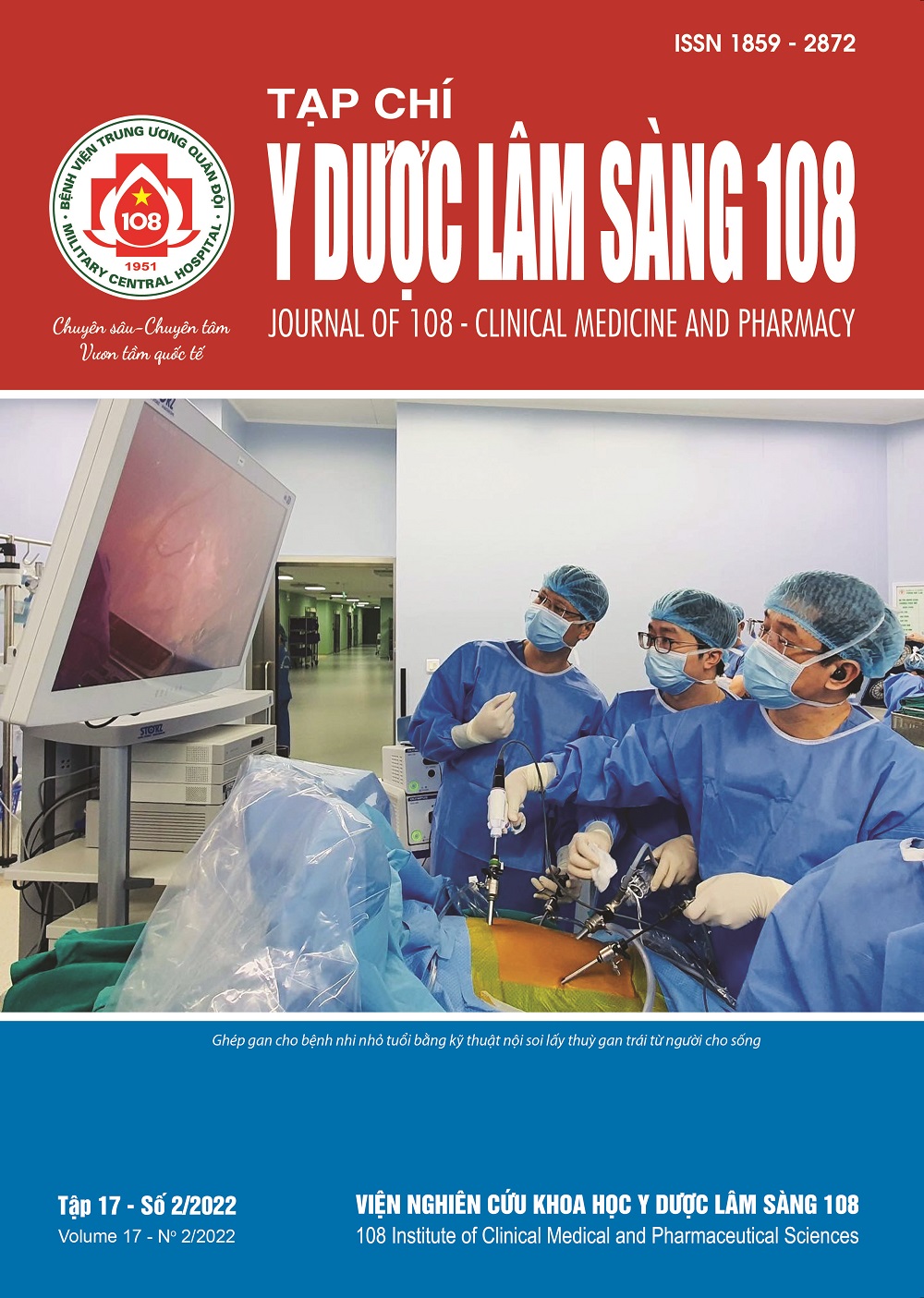The apoB/apoA-I ratio and relationship with intracranial atherosclerosis in ischemic stroke patients
Main Article Content
Keywords
Abstract
Objective: To evaluate concentrations of apolipoprotein A-I, apolipoprotein B, apolipoprotein B/apolipoprotein A-I ratio according to cerebral atherosclerosis in ischemic stroke patients. To determine the prognostic value of atherosclerotic stenosis, occlusion of intracranial arteries in ischemic stroke patients of the apoB/apoA-I ratio. Subject and method: 248 ischemic stroke patients (IS) were examined and treated at 108 Military Central Hospital from 10/2017 - 12/2019. The patient group were divided into 2 groups: large atherosclerostic artery stroke (n = 146) and small artery occlusive stroke (n = 102). Cross-sectional descriptive prospective study method. Patients were examined clinically, diagnosed with imaging and tested apoA-I, apoB, apoB/apoA-I ratio on admission. Result: The apoB concentration, apoB/apoA-I ratio of the intracranial atherosclerosis group was higher than that of the extracranial atherosclerosis group (1.34 ± 0.3g/l and 1.22 ± 0.27g/l; 1.19 ± 0.33 and 0.97 ± 0.35) with p<0.05. Patients with one site stenosis, occlusion had higher apoA-I concentration; apoB concentration, apoB/apoA-I ratio were lower than patients with multiple sites stenosis, occlusion with p<0.05 and p<0.01. The apoB concentration, apoB/apoA-I ratio were lowest in the group of moderate stenosis to severe stenosis and highest in the occlusion group. The apoA-I concentration was inversely correlated with the degree of stenosis and occlusion (r = -0.34, p<0.01). The apoB concentration, the apoB/apoA-I ratio were positively correlated with the degree of cerebral artery stenosis, occlusion (r = 0.35, p<0.01 and r = 0.41, p<0.01). Multivariate analysis of intracranial atherosclerosis group: apoB/apoA-I ratio with OR = 3.543; 95% CI (1.074 - 11.632); p<0.05. The cut-off value was 0.965 (sensitivity: 63%; specificity: 55%). Conclusion: ApoA-I concentration, apoB concentration, apoB/apoA-I ratio change according to the state of cerebral atherosclerosis. The apoB/apoA-I ratio is an independent predictor of intracranial atherosclerosis in ischemic stroke patients.
Article Details
References
2. Wang Y, Zhao X, Liu L et al (2014) Prevalence and outcomes of symptomatic intracranial large artery stenoses and occlusions in China: The Chinese Intracranial Atherosclerosis (CICAS) study. Stroke 45(3): 663-669.
3. Schmidt C, Wikstrand J (2009) High apoB/apoA-I ratio is associated with increased progression rate of carotid artery intima-media thickness in clinically healthy 58-year-old men: Experiences from very long-term follow-up in the AIR study. Atherosclerosis 205: 284-289.
4. Park JH, Hong KS, Lee EJ et al (2011) High levels of apolipoprotein B/AI ratio are associated with intracranial atherosclerotic stenosis. Stroke 42: 3040-3046.
5. Adams HP, Bendixen BH, Kappelle LJ et al (1993) Classification of subtype of acute ischemic stroke. Definitions for use in a multicenter clinical trial. TOAST. Trial of Org 10172 in Acute Stroke Treatment. Stroke 24(1): 35-41.
6. Owen BS, Gregg JJ, Michael JL et al (2000) A standardized method for measuring intracranial arterial stenosis. American Journal of Neuroradiology 21(4): 643-646.
7. U-King-Im JM, Trivedi RA, Cross JJ et al (2004) Measuring carotid stenosis on contrast-enhanced magnetic resonance angiography: Diagnostic performance and reproducibility of 3 different methods. Stroke 35(9): 2083-2088.
8. Li MM, Lin YY, Huang YH et al (2015) Association of apolipoprotein A1, B with stenosis of intracranial and extracranial arteries in patients with cerebral infarction. Clin Lab 61(11): 1727-1735.
9. Fahmy EM, El Awady MAE, Sharaf SAA et al (2020) Apolipoproteins A1 and B and their ratio in acute ischemic stroke patients with intracranial and extracranial arterial stenosis: An Egyptian study Ebtesam Mohammed. Egypt J Neurol Psychiatry Neurosurg 56: 115.
10. Sun Y, Hou XH, Wang DD (2019) Apolipoprotein B/AI ratio as an independent risk factor for intracranial atherosclerotic stenosis. Aging (Albany NY) 11(17): 6851-6862.
11. Cuomo S, Guarini P, Gaeta G et al (2002) Increased carotid intima-media thickness in children-adolescents, and young adults with a parental history of premature myocardial infarction. Eur Heart J 23(17): 1345-1350.
12. Hamsten A, Walldius G, Szamosi A et al (1986) Relationship of angiographically defined coronary artery disease to serum lipoproteins and apolipoproteins in young survivors of myocardial infarction. Circulation 73(6): 1097-1110.
13. Yang WS, Li R, Shen YQ et al (2020) Importance of lipid ratios for predicting intracranial atherosclerotic stenosis. Lipids in Health and Disease 19: 160.
 ISSN: 1859 - 2872
ISSN: 1859 - 2872
